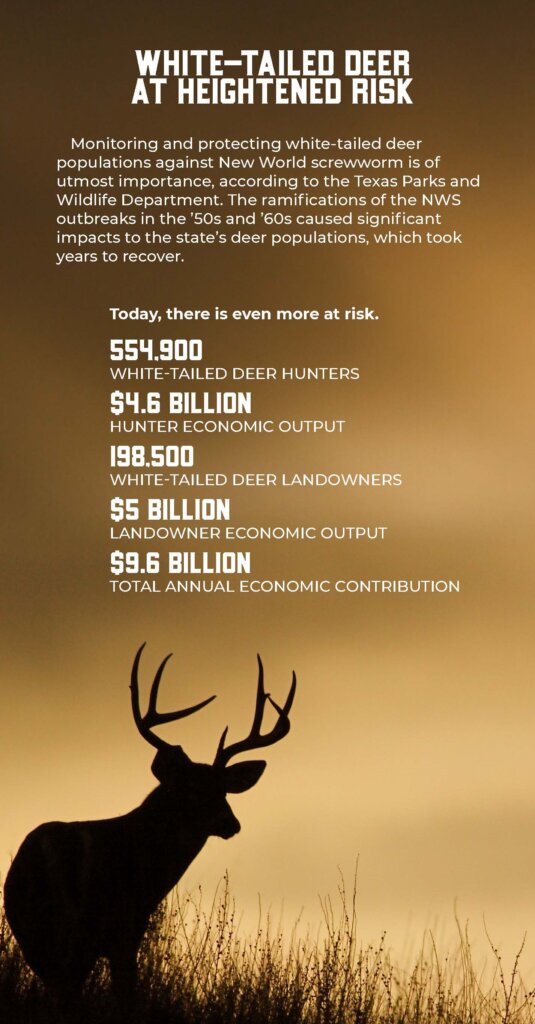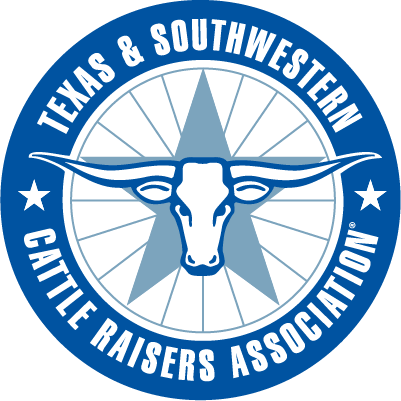Diligent surveillance efforts are crucial to protecting against New World screwworm.
By Diane Meyer

A ranch truck jolts along a dirt road, crawling to a stop as its headlights illuminate a hunting blind. In the dark morning twilight, a hunter climbs in and settles into a folding chair, rifle and binoculars ready. As dawn breaks, sunlight reveals a few fawns, does, birds and young bucks at a distant feeder.
Suddenly, a doe freezes, sniffing the air. Glassing the ridge, the hunter spots a 10-point buck emerging 200 yards out. Heart racing, he steadies his .270 Winchester, aims and fires. The herd scatters — except one.
The thrill of the hunt draws people from around the world to Texas for its abundance of game, particularly white-tailed deer. By far, white-tailed deer are the most popular species managed by the state’s landowners.
A joint survey released in December 2023 by Texas A&M University’s department of rangeland, wildlife and fisheries management and the Natural Resources Institute found Texas has roughly 554,900 white-tailed deer hunters who generate $4.6 billion in annual economic output. Factoring in revenue from 198,500 landowners, that figure rises to $9.6 billion statewide.
Today, with rural economies and landowners increasingly reliant on income from wildlife management, the stakes are especially high to protect wildlife populations. As the threat of New World screwworm approaches the U.S.-Mexico border, serious efforts are underway to safeguard Texas wildlife.
A growing concern
A fly that feeds on the living tissue of warm-blooded animals, NWS is well known for its toll on livestock. This parasitic fly’s larvae can also feed on pets, humans and wildlife. They can infest any wound, such as an umbilical cord or tick bite, leading to a condition known as myiasis.
Wildlife populations are particularly vulnerable, as they are not monitored as consistently as livestock herds. Free-ranging wildlife species — which are not kept in enclosed conditions and cannot be readily captured or examined — make disease detection and management significantly more challenging.

“All wildlife are important, but particularly when we look at New World screwworm infestations, we really need to be cognizant of what that is going to do to our wild deer populations because of the economic impact it could have on the hunting industry in Texas,” said Kory Gann, Texas Parks and Wildlife Department big game program director, during the 2025 TSCRA Summer Meeting in San Antonio, June 21.
In South Texas, Gann explained, NWS kept wildlife populations suppressed until its eradication in the late 1960s. White-tailed deer were especially impacted. While data is limited, regional reports suggest one-third to one-half of populations were lost during heavy infestation years. Fawns experienced mortality rates as high as 40% to 80% following mild winters due to their high susceptibility to navel infection.
According to a study published in the Journal of the American Veterinary Medical Association, screwworm infestations were documented as early as the 1930s in eastern cottontails, jackrabbits, opossums and white-tailed deer. In one case, more than 500 flies emerged from a single infected jackrabbit in Texas.
While ranchers of that time managed infestations in livestock, wild animals — rarely captured or treated — continued to fuel outbreaks. Wildlife served as untreated reservoirs for the parasite, posing a major challenge to eradication. Screwworm elimination not only allowed deer populations to rebound, but it also laid a foundation for game ranching in the region.
Beginning in the late 1950s through the 1970s, white-tailed deer numbers increased sharply statewide, thanks in part to regulatory changes, reduced harvests and, notably, the sterile insect technique used to eradicate NWS. This method of eradication, which is being deployed today, involves releasing millions of sterilized male NWS flies to mate with wild females, resulting in no offspring and ultimately collapsing the population.
“Texas’ deer populations have come a long way since the 1940s,” Gann said. “We have
localized reports of populations doubling and tripling the decade after eradication on properties in South Texas.”
Eradication is also credited with contributing to the boom in feral hog populations — an unwelcome development for many landowners and producers due to the pigs’ destructive behavior.
At time of press, NWS are spreading north through Mexico, with confirmed cases in Veracruz and Oaxaca. A key concern is the lack of wildlife surveillance in Mexico, unlike Texas, where USDA and the Texas Animal Health Commission lead monitoring efforts with support from Texas Parks and Wildlife. As eradication efforts ramp up, early detection is essential to target areas for sterile fly releases.
A case for careful reporting
A 2016 outbreak in the Florida Keys underscores the importance of timely reporting to contain NWS.
The most recent U.S. occurrence, which was the first confirmed, locally-acquired infection in more than 30 years, wiped out about 15% of the state’s endangered Key deer population. Most deaths occurred during the rut in September and October, a period when bucks, already wounded from shedding velvet, are prone to additional injuries from fighting.
In an AgriLife Today article, Phillip Kaufman, Ph.D., head of Texas A&M University’s department of entomology, discussed how the Florida outbreak highlights the severity of the NWS threat and the need for early action. At the time, Kaufman was an associate professor and Extension scientist for the University of Florida’s Institute of Food and Agricultural Sciences and a key informant on the fly’s behavior.
Control measures included setting up inspection stations, conducting public outreach and releasing 188 million sterile flies. The island setting made it possible to contain and treat individual deer.

However, this incident may have been preventable, or less severe, had proper reporting occurred. Under federal law, any maggot found infesting a living mammal must be removed and submitted to USDA’s Animal and Plant Health Inspection Service for identification. In late June 2016, a veterinarian removed maggots from a case of myiasis but failed to submit them for inspection.
In August, as deer began shedding velvet, open wounds formed at the base of antlers, which are ideal sites for NWS egg-laying. “The number of flies blew up very quickly,” Kaufman said. “It only takes a couple of weeks for that fly to go through its whole development … and a female fly can lay more than 200 eggs at a time, typically.”
Because the deer were comfortable around people, residents soon noticed the maggot infestations. By the time APHIS was alerted in September, the outbreak had intensified. Roughly 80% of bucks of that endangered species were wiped out before eradication was declared in March 2017.
Based on this case, Kaufman urges anyone who finds an infested animal to first call a veterinarian, and second, ensure the maggots are submitted for testing.
He also recommends wildlife facilities develop herd management plans and consider tracking high-value animals. “If you are running a wildlife facility, you need to have a biosafety plan,” he said in AgriLife Today. “Develop a surveillance program for your ranch and have a list of veterinarians and resources on hand.”
Roel Lopez, Ph.D., director of the Texas A&M Natural Resources Institute and head of the Texas A&M department of rangeland, wildlife and fisheries management, was also a key player in monitoring deer populations during the outbreak. He noted the tremendous degree of multi-agency coordination that was needed to eradicate NWS in the Florida Keys.
“The biggest lesson I learned was the importance of rapid, interagency coordination,” he said. “No one agency can do it themselves — it requires a cohesive effort.”
Containment efforts
Recognizing the need for collaboration, a coalition of organizations, including Texas & Southwestern Cattle Raisers Association, has formed to ensure widespread awareness. The Screwworm Coalition of Texas directs individuals to report suspected infestations in pets and livestock to the Texas Animal Health Commission. Wildlife cases should be reported to the Texas Parks and Wildlife Department.
“If you have a suspected case, contact us immediately,” Gann said. “We can authorize removal and proper carcass disposal.”
Currently, Texas Parks and Wildlife has trained 60 biologists and game wardens in South Texas on sampling procedures. “Our biologists and game wardens are getting daily calls about potential cases,” Gann shared. “We’re training staff on larval collection and sample submission and preparing for active surveillance on state parks and wildlife management areas.”
The department has also formed an internal NWS response team of wildlife, communications, law enforcement and park staff. They are developing guidance for hunters and landowners, especially those in the Managed Lands Deer Program or Texas Parks and Wildlife Department’s technical guidance program.
The department awaits the Texas Animal Health Commission’s response plan, currently under USDA review, which will outline protocols for positive cases. “We want to stay in lockstep with the [Texas Animal] Health Commission and USDA to determine our role in the response,” Gann said.
Responses to confirmed cases will include the sterile insect technique and may involve animal movement restrictions and inspections from control zones. Wildlife breeders and rehabilitators will likely face inspection requirements for live animal movement.
Carcass movement controls are also being explored. Hunters will be advised to skin and quarter harvested deer to limit larval spread. Incineration is the preferred method of disposing infected carcasses, though chemical treatment or prolonged freezing of infested tissue are alternatives.
Texas Parks and Wildlife is also considering active surveillance on its South Texas lands, including state parks and wildlife areas. In addition, the department is developing an out-of-season take authorization for disease surveillance. The existing individual take authorization — originally developed for chronic wasting disease — could be modified for NWS, allowing landowners or agents to remove animals with required reporting and testing.

Similar to the case of chronic wasting disease management, there will be flexibility to manage NWS outbreaks under the department’s Managed Lands Deer Program, which is designed to promote and support responsible wildlife management and habitat conservation on private lands in Texas.
“Harvest recommendations can be adjusted at the individual MLDP property level,” said Blaise Korzekwa, Texas Parks and Wildlife white-tailed deer program leader. “If NWS shows up, we can work with landowners to either issue more tags to lower deer density or recommend they reduce doe harvest, depending on their goals.”
Reducing doe harvest may be particularly important in drought-stricken regions like South Texas and the Edwards Plateau, where fawn recruitment is already low.
For non-Managed Lands Deer Program participants, Texas Parks and Wildlife uses deer survey and herd composition data from deer management units based on ecological region, hunter density and population estimates. If an outbreak affects the deer population at the deer-management-unit scale, these changes will be noticed through annual surveys.
“Just like livestock producers, good surveillance and animal care will be crucial,” Korzekwa said. “With Texas being such a large, privately owned state, landowners and managers will be on the frontlines. If we don’t follow best practices, NWS will be much more difficult to eradicate without serious consequences.”
—-
Diane Meyer is the associate director of content for Grant Company based in St. Joseph, Missouri.
###

